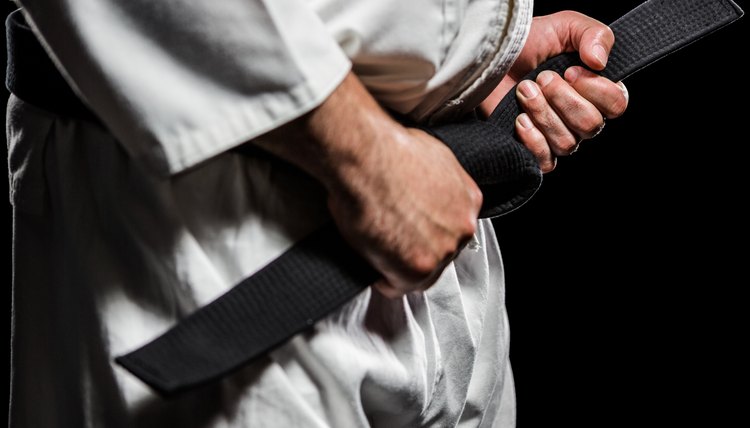Belt Levels in Jujitsu

Jujitsu, like many other martial arts, uses a ranking system based on belts. Each belt has a unique color and is used to represent the skill level of the student. Lower-level belts can typically be earned in a few months, whereas higher-level belts can take many years. The belt levels and colors in traditional jujitsu are similar to most other traditional martial arts, such as judo, karate and tae kwon do.
White
The white belt is the entry-level belt in jujitsu. It's a gentle introduction to jujitsu moves, including basic kicks, strikes, punches, blocks and throws.
Red
The red belt is the second-level belt in jujitsu. In training for this belt, you will learn more strikes and blocks, as well as the hip throw.
Yellow
The yellow belt is typically the second-level belt in most martial arts, but in jujitsu it is the third. You typically have to demonstrate elbow strikes and some standing arm locks. You will have also learned some ground-fighting techniques.
Orange
The orange belt is the fourth-level belt in jujitsu. At this rank, you are still considered a beginner and have much to learn but are on your way to becoming an intermediate student. More advanced throws are taught for different situations, and you will learn more ground-fighting techniques.
Green
The green belt is the fifth-level belt. This is the first intermediate belt. It can take one year up to several years to earn this belt, depending on the school and your learning pace. At this stage, you'll learn more kicks and combinations, as well as variations of the hip throw. The green belt is also the first level where you begin to focus more on throws and less on ground work.
Red more: Is Jiu-Jitsu More Effective Than Kickboxing?
Blue
The blue belt is the sixth-level belt in jujitsu and the second intermediate rank. You will continue to improve upon the skills you learned as a green belt, such as more advanced throws, escapes and engaging your opponent.
Purple
The purple belt is the stage between intermediate and advanced. It typically takes several years for someone with no martial arts training to advance from white to purple. At this stage you should have most of the techniques down, but you are still working on the details and being analytical.
Brown
The brown belt is for someone who is advanced at jujitsu. At this level, you are close to being considered an expert and can demonstrate a variety of difficult techniques. At this stage you are sharpening your submissions and fixing any weaknesses you may have.
Black
The black belt is the highest rank in traditional jujitsu. Someone who possesses a black belt is considered an expert. The time it takes to earn a black belt in jujitsu depends on the school. Some schools are less strict and it is feasible you could be in a black belt in a few years if you work hard enough. But it could take you 10 years to earn a black belt at a school that is stricter.
Brazilian Jujitsu
The belt levels in Brazilian jujitsu, or BJJ, are different than in traditional jujitsu. There are only five belt levels in BJJ -- white, blue, purple, brown and black. Some BJJ schools may incorporate the other colors so students can feel like they are progressing quickly and so they maintain interest, because the transition can sometimes take years between belts.
References
- Jiu-Jitsu Times: Purple Belt a.k.a. “The Rolling Belt”
- Tang R, Holland M, Milbauer M, et al. Biomechanical Evaluations of Bed-to-Wheelchair Transfer: Gait Belt Versus Walking Belt. Workplace Health Saf. 2018;66(8):384-392.
Writer Bio
Jason Jensen began his professional freelance writing career in 2010. He is an ACT-certified personal trainer and longtime vegetarian with an enthusiasm for fitness and nutrition. Jensen has also worked as a musician, freelance photographer, audio engineer and Web designer.
